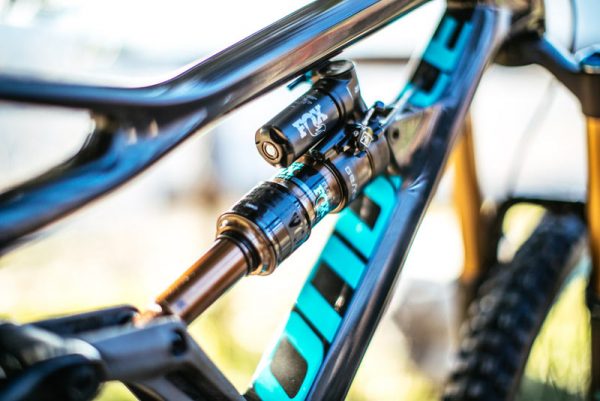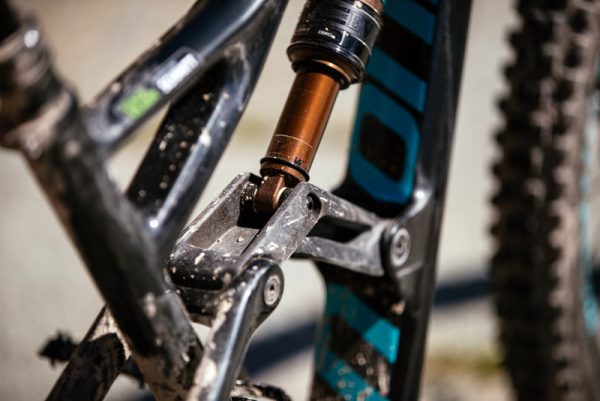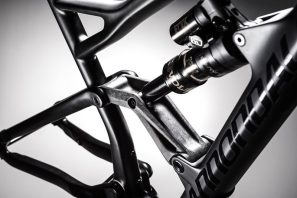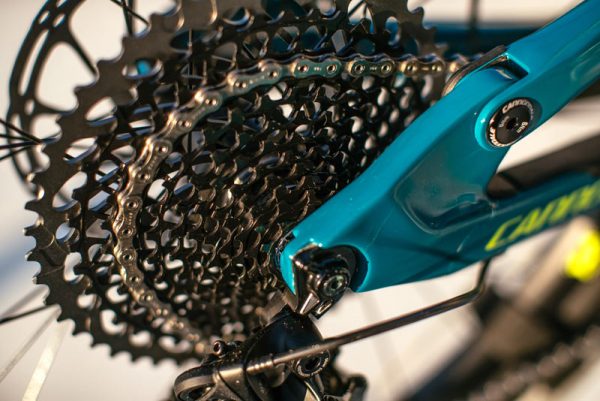Cannondale has completely redesigned their Jekyll enduro and Trigger trail mountain bikes, giving them more aggressive geometry, plus an all-new suspension design and dual-travel shock.
The bikes differ in travel but share a lot of the same updates – here’s what’s similar: Both frames are completely new, both have 27.5″ wheels, both use a linkage driven push shock running in line with the seat stays rather than the seat tube like before, and both get slacker geometry. Visually, they’re similar to each other but a vast departure from the outgoing models introduced in 2014. They use a full carbon fiber linkage, BallisTec carbon in the frames, thru-axle pivot links, ISCG05 tabs, and very short 420mm chainstays thanks to their Ai Asymmetric Integration with offset drivetrain. And both bikes see 5mm rear travel increases, with a glaring absence of the Lefty SuperMax fork on any models.
FOX GEMINI SHOCK
At the heart of both bikes is the all-new Fox Gemini shock, which differs from the prior dual travel DYAD shock in a couple of key ways. First, it’s a helluva lot simpler. Gone is the dual chamber and damping cartridge layout, replaced with a traditional looking Fox Float X or Float DPS air can. It has Hustle and Flow modes, designed for pedally, climb sections or all-out descending, respectively. They’re specifically calling out Hustle as more than just “climb” mode, saying their pro athletes are using it on rollers and less steep sections to get a little more power down when seconds count. Call them “ride” modes.
The premise is the same as with DYAD – limit travel to obtain a “short travel” mode with characteristics suited to climbing or pedaling hard. The method is different, though, in that this one reduces travel 20% by simply limiting total air volume.
The air can has two extended volume collars, the normal EVOL one at the bottom, and an extra air sleeve at the top where the control enters the shock. When in Flow mode, you’re using all available air volume. In Hustle mode, you’re closing off part of the air chamber, which means that initial travel will feel just as supple over the small stuff, but it’ll ramp harder as you move into the travel. Eventually, it’ll hit a point where it can’t compress any more, thus limiting the travel. Open it up and it changes the curve to allow full travel.
It’s really about changing the “feel” of the bike more than changing the travel, but that’s what happens. Because of this, the damping tune doesn’t need to change when you change ride modes, they’ve simply tuned it to perform well in both modes. And all of this happens while still providing the usual external compression and rebound controls.
The geometry is based on Flow mode with 30% sag in the shock. Hustle mode will have less sag, which means the BB will sit a little higher and angles will be slightly steeper, but not nearly as dramatic as they did with the DYAD equipped. As such, they aren’t claiming any specific angle or BB height changes because they say it’s very minimal.
Up above, that green thing is a volume spacer, and the black part is their new Ramp Ring, both of which only affect the performance in Flow mode. Traditionally Fox provides volume spacers in fixed sizes. But they needed a different solution, and they wanted one part to work across both bikes and both Float X and Float DPS shocks. The Ramp Ring lets them use a single part to tune the ramp progression, and that progression can be changed by adding more rings. Fair warning, this is not a user-serviceable tuning feature, you’d have to send it in or your shop would have to purchase specialized parts to do this.
As for the lack of Lefty SuperMax spec, they say the additional stiffness it provided over the big 34mm and 36mm stanchion forks they’re spec’ing here was beyond what the market needed. That, and it’s probably an easier sell.
2018 CANNONDALE JEKYLL
The Jekyll is the bigger bike of the two and is the enduro race rig of choice for Jerome Clementz. Compared to the previous model, the shock sits much higher and is more directly driven by the linkage. On both bikes, they’re claiming a full size water bottle will fit inside the front triangle, under the linkage.
It gets a full two degree slacker head angle than before, coming in at 65º. It’s built around a 35mm stem and has a 75º seat angle to keep you in an aggressive riding position.
Rear travel is 165mm in Flow mode and 130mm in Hustle. Up front is a 170mm fork. Note the full thru-axles running between the main pivot points. Not only are they stiffer than single bolts at either end, they’re also very easy to service.
Max tire size is claimed at 2.6, which means it’s not really a plus bike, but they say there is a lot of clearance with that size tire.
Underneath the downtube is a full carbon shield. All cables are run internally, and there are ports for 1x, 2x, dropper, shock remote and internal battery mounts and wiring runs for Di2.
Can you guess what might be coming down the trail? The Jekyll uses flat mount brake mounts, but will require adapters (for now) to fit current calipers.
The Jekyll will come in both carbon and alloy models, stay tuned for a second post with all models, spec options and geometry charts.
2018 CANNONDALE TRIGGER
The Trigger is their all-mountain and trail bike, meant more for the everyday aggressive rider that is likely to spend saddle time in more flowing trails but still wants to get rowdy.
It has a slightly steeper 66º head angle, also two degrees slacker than before, with reach designed for a 45mm stem. Seat angle is 74.5º. Cable ports are designed to allow plenty of visibility inside while routing hoses and cables, making it easier to set up or swap placement to suit your preferences.
Rear travel is 145mm in Flow mode, and is limited to 115mm in Hustle. Forks get 150mm travel.
Those carbon Descendant cranks SRAM teased last year? Here they are!
A reinforced derailleur hanger sandwiches the carbon dropout section.

The Trigger comes in all carbon front triangles, with some models getting an alloy rear end. Look for another post soon with full specs, options and geometry charts for both bikes.





















